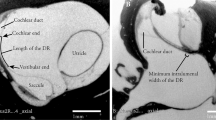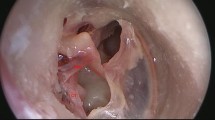Summary
The aim of this study was to correlate current morphologic data relating to the lumen of the auditory tube. Four methods were used: dissection under the operating microscope; microendoscopy of the tubal lumen; optical and electron microscope histology; and MR or CT imaging. The auditory tube consists of two unequal cones, a small posterior third, fixed and osseous (protympanum), and a mobile fibrocartilaginous anterior two-thirds, both joined by the tubal isthmus, a short constriction which is pseudosphincteric at endoscopy. The tensor veli palatini muscle (TVPM) and the levator veli palatini muscle (LVPM) are the chief muscles that vary the tubal lumen of the fibrocartilaginous portion, which is collapsed at rest. CT and especially MR imaging allows their observation in static conditions. Serial histologic sections reveal the continuity between the TVPM and the tensor tympani muscle. The main cartilage framing the lumen varies in shape according to the level surveyed. The tubal mucosa is lined with an epithelium combining ciliated and mucus cells, involved in mucociliary drainage and gas exchanges in the auditory tube. These morphologic elements represent a basis for study of tubal physiology and for planning treatment in dysfunctions of the auditory tube.
Résumé
Ce travail a pour but la confrontation des données morphologiques actuelles concernant la lumière de la trompe auditive (tuba auditiva) ou trompe d'Eustache. 4 méthodes ont été utilisées: la dissection effectuée avec un microscope opératoire, la micro endoscopie de la lumière tubaire, I'histologie en microscopie optique et électronique, I'imagerie par résonance magnétique nucléaire ou tomodensitométrie. La trompe auditive est faite de deux cônes inégaux, I'un petit (1/3) postérieur, fixe et osseux (protympanum), I'autre plus allongé (2/3), mobile fibro-cartilagineux, réunis tous deux par l'isthme tubaire, étranglement court, pseudo-sphinctérien en endoscopie. Le muscle tenseur du voile du palais (MTVP) et le muscle élévateur du voile du palais sont les principaux muscles faisant varier la lumière tubaire de la portion fibro-cartilagineuse, colla∼ée au repos. L'imagerie en TDM et surtout en IRM permet de les observer de façon statique. Les coupes sériées en histologie révèlent la continuité entre le MTVP et le muscle tenseur du tympan. Le cartilage principal, armature de la lumière a une forme variable suivant la hauteur considérée. La muqueuse tubaire est tapissée d'un épithélium associant cellules ciliées et cellules à mucus, participant au drainage muco-ciliaire et aux échanges gazeux de la trompe auditive. Ces éléments morphologiques représentent une base pour l'étude de la physiologie tubaire, et I'orientation thérapeutique des dysfonctions de la trompe auditive.
Similar content being viewed by others
References
Bluestone CD, Paradise JL, Beery QC (1972) Physiology of the Eustachian tube in the pathogenesis and management of middle ear effusions. Laryngoscope 82: 1954–1970
Bluestone CD, Klein JO (1995) Anatomy. In: Otitis media in infants and children, 2nd ed. Saunders, Pittsburgh, pp. 5–15
Cantekin El, Doyle WJ, Reichert TJ (1979) Dilatation of the Eustachian tube by electrical stimulation of the trigeminal nerve. Ann Otol Rhinol Laryngol 88: 40–51
Chays A, Cohen JM, Magnan J (1992) Endoscopie de la trompe d'Eustache. Jf Orl 41: 263–268
Frachet B (1984) Physiologie de la trompe d'Eustache. In: Physiologie des voies aérodigestives supérieures. Uziel A, Guerrier Y Masson, Paris, pp. 43–58
Graves GO, Edwards IF (1944) The Eustachian tube. A review of its descriptive, microscopic, topographic and clinical anatomy. Arch Otolaryngol 39: 359–397
Hentzer E (1970) Histological studies of the normal mucosa in the middle ear, the mastoid cavities and the Eustachian tube. Ann Otol 79: 825–830
Hiraide F, Inouyet I (1983) The fine surface view of the adult Eustachian tube. J Laryngol Otol 97: 149–57
Honjo J, Ushiro K, Nozoe T, Okazaki N (1983) Cineroentgenographic and electromyographic studies of Eustachian tube function. Arch Otorhinolaryngol 238: 63–70
Martin C, Magnan J, Bebear JP (1996) Physiologie de la trompe auditive. In: La trompe auditive (la trompe d'Eustache). Soc Franç. ORL Path Cervico-Faciale. Arnette Blackwell, Paris, pp. 68–75
Matsune S, Sando I. Takamashi M (1992). Distributions of Eustachian tube goblet cells and glands in children with and without otitis media. Ann Otol Rhinol Laryngol 101: 750–754
Naito Y, Mirono Y, Honjo I, Mori C, Moschino K, Nishimura K, Narano (1987). Magnetic resonance imaging of the Eustachian tube. A correlative anatomic study. Arch Otolaryngol Head Neck Surg 113: 1281–1284
Proctor B (1973). Anatomy of the Eustachian tube. Arch Otolaryngol 97: 2–8
Robert Y, Gaillandre L, Chaillet N, Francke JP (1994). Serial anatomy of the auditoriy tube: correlction to Ct and MR imaging. Surg Radiol Anat 16: 63–69
Sade J, Wolfdson S, Luntz M, Berger G, (1985). the anatomical regions of Eustachian tube. In: The Eustachian tube. Proceedings of the international conference on acute and secretory otitis media. Part II. Jerusalem Israel Nov. Kugler, Amsterdam; pp. 28–35
Sade J, Luntz M, Levy D (1995) Middle ear gas composition and middle ear aeration. Ann Otol Rhinol 104: 369–373
Sando I, Takamashi M, Matjune S, Aoki H (1994) Localization of function in Eustachian tube: a hypothesis. Ann Otol Rhinol Laryngol 103: 311–314
Terracol J, Corone A, Guerrier Y (1949) La trompe auditive. Masson, Paris, pp. 23–52
Thorn-Kany M, Bonafe A, Veyret C (1996) Imagerie de la trompe auditive. In: La trompe auditive (la trompe d'Eustache). Soc Franç ORL Path Cervico-Faciale. Arnette Blackwell Paris, pp. 237–246
Tos M (1985) Histologic anatomy of the Eustachian tube and middle ear. Ann Otol Suppl X: 9–11
Yamashita K (1991) Endoscopic aspects in Eustachian tube dysfunction. In: Eustachian tube and middle ear diseases. Sadé, Kugler, Amsterdam, pp. 169–173
Author information
Authors and Affiliations
Rights and permissions
About this article
Cite this article
Prades, J.M., Dumollard, J.M., Calloc'h, F. et al. Descriptive anatomy of the human auditory tube. Surg Radiol Anat 20, 335–340 (1998). https://doi.org/10.1007/BF01630616
Received:
Accepted:
Issue Date:
DOI: https://doi.org/10.1007/BF01630616




